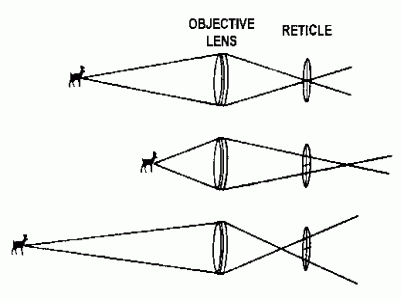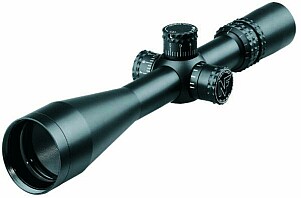|
Parallax in Rifle Scopes
OPTICS TECH: PARALLAX EXPLAINED (Analysis by U.S. Optics)
Whenever rifle scopes are discussed, a topic that frequently arises is parallax. There seems to be a great amount of misunderstanding and confusion concerning this subject. Parallax can be defined appropriately to rifle scopes as the apparent movement of objects within the field of view in relation to the reticle.
 In a telescopic sight, parallax occurs when the “primary image” of the object is formed either in front of, or behind the reticle. If the eye is moved from the optical axis of the scope, this also creates parallax. In a telescopic sight, parallax occurs when the “primary image” of the object is formed either in front of, or behind the reticle. If the eye is moved from the optical axis of the scope, this also creates parallax.
If the primary image is formed on the same focal plane as the reticle, or if the eye is positioned in the optical axis of the scope, then there is no parallax, regardless of the position of the primary image.
High magnification scopes, or scopes for long-range shooting, where even slight sighting errors would be serious, should be equipped with a parallax adjustment. This adjustment of the objective part of the optical system would ensure that the target can be brought in the exact focal plane of the reticle at any distance. Tactical style scopes are not usually supplied with parallax adjustment because the exact range of the target can never be anticipated. Scopes of lower magnification are not usually supplied with parallax adjustment either, because at lower powers the amount of parallax is so small as to have no importance for practical, fast target acquisition.

TWO FACTORS WHICH CAUSE AND DETERMINE THE AMOUNT OF PARALLAX IN A RIFLESCOPE:
1. The distance of the target to the objective--The objective lens forms a primary image of the subject being viewed and subsequent components invert the image, and there is no parallax. The actual position at which the image is formed is dependent on the distance the target is from the objective. Closer targets are formed farther away from the objective and farther targets are formed closer to the objective. Since the reticle is in a fixed position within the scope housing, the image is not always formed in the same plane as the reticle and, hence parallax.
2. The distance the eye can move from the optical axis of the scope, is determined by exit pupil size. There is no parallax, at any distance, as long as the eye is lined up exactly with the optical axis of the scope. An exit pupil small enough to do this would be impractical. It is important to know that in every scope, there is some parallax. It is also important to know that in every scope, there is some one shooting distance at which there is no parallax. In most rifle scopes this one point of zero parallax is usually placed at a suitable mid-range point in the scopes' focal range.
In lower-quality scopes, there are other sources of parallax. If the reticle is not precisely placed the correct distance from the objective, the distance of no parallax will be exaggerated. Reticles that are not securely mounted and allowed to move even a few thousandths of an inch, will always have changing amounts of parallax. Parallax is also caused by optical deficiencies in the objective, either by design or manufacture. If spherical or astigmatic aberrations have not been corrected, images will form a considerable distance from the reticle. If you see a scope in which the apparent movement of the reticle compared with the image viewed is different from when you move your eye up and down than when you mover your eye side to side, it is because of a bad objective. No adjustment of the scope will eliminate these faults or optical deficiencies.
You can check the parallax of any scope by sighting an object at normal shooting distance (not indoors), by moving your eye side to side (then up and down), as far as you can, keeping the sighted object within the field of view. The apparent movement of the reticle in relation the target is parallax.

PARALLAX CORRECTIVE METHODS (Optics Design)
I. REAR (SECOND FOCAL PLANE TYPE) CORRECTIVE ADJUSTMENTS.
This feature is usually a numbered range ring from minimum yardage (usually 50) to maximum yardage (usually infinity) and sets directly in front of the eyepiece, similar to the usual variable power ring but controls the Parallax Adjustment. This is almost always found only on fixed power scopes, due to the internal construction. This adjustment is usually found on scopes of more than 8x and less than 20x. Some Examples are Tasco, Phrobis and Baush&Lomb tactical scopes.
Advantages:
• Is near the shooter and can be reached easily. Cheap to make.
Disadvantages:
• Very coarse adjustment and hard to use, especially on higher power.
• Left eye cannot see the yardage indicator while looking through the scope and movement is extremely coarse.
• Difficult, if not impossible, to make work on conventional variable-power scopes.
II. MIDDLE (TURRET/SADDLE TYPE) CORRECTIVE METHOD
 Usually on left side of turret with yardage increments printed around the radius of a third knob. Designed to be easily reachable and adjustable with left hand while looking through scope. An example is Leupold Mark IV Tactical (or NightForce NXS in illustration). Usually on left side of turret with yardage increments printed around the radius of a third knob. Designed to be easily reachable and adjustable with left hand while looking through scope. An example is Leupold Mark IV Tactical (or NightForce NXS in illustration).
Advantages:
• Easy reachable from shooting position.
Disadvantages:
• Most companies using this style build it in such a way as to not be able to easily read the yardage numbers without shifting ones head from the eyepiece. This lessens the utility.
• With some other brands of scopes we've tested it is difficult to achieve maximum target sharpness with near-zero parallax. There are many reasons for this, including sloppy production tolerances.
• Is very coarse and not as finely tunable, particularly at higher power without putting a very large (3" or larger) knob on, which again, defeats the concept.
• Has more mechanical systems to fail. More expensive to make, if done well
[EDITOR'S NOTE: When using Leupold side-focus scopes, such as the 6.5-20X LRT, lash in the focus knob can lead to focusing problems. When this happens your target is slightly out-of-focus when you've got the parallax "dialed-down" as much as possible. To get better, more repeatable focus, you should rotate the side-focus knob ALL the way forward to the infinity stop before setting the parallax adjustment. Go slowly. If you go past the point where parallax is minimized and focus is sharp, then go all the way back to the infinity stop and start again.]
III. FRONT (OBJECTIVE LENS TYPE)

This is one of the oldest, most proven and still the probably the best and most versatile system optically and mechanically. Either very fine or rapid gain fast threads can be used, depending on the application. If made properly, it can be as rugged and abuse resistant, as the three other types of adjustment, while offering many advantages the first two methods don’t have. This method is usually seen as a fixed objective, (set at the factory and non-adjustable w/o special tools), or fully adjustable by hand.
Advantages:
• Optically the most proven and efficient.
• Mechanically, the most versatile and effective way.
• Historically, fixed objective scopes up to 10x have been most accepted by the military because of ruggedness.
Disadvantages:
• On extremely long scopes can be hard to reach from the shooter’s position.
• Cannot easily see the range or yardage increments from shooter’s position.
• Can Leak easier,( on hand adjustable models), if not made well
IV. U.S. OPTICS "ERGO" ADJUSTMENT SYSTEM

After many years of designing and building scopes for myself and other companies, we think this system, which is a refinement of #3 above, has all the advantages of the above systems and none of the disadvantages. Those advantages are:
• One can see the yardage increments very clearly with the left eye while looking through the scope with the right eye.
• Is easily reachable while in shooting position.
• Has a finer adjustment than knob-turret type designs.
• Can be made to accommodate slow or rapid gain operation, depending on the need and application.
• Can be made as rugged and sealable as necessary.
• Is modularly modifiable for different applications.
US Optics can build all four of the above systems, depending on the need, but prefer and recommend the #4 ERGO system by far.
Copyright © 2005, U.S. Optics, All Rights Reserved, used by permission.
Topics: Reticle, Objective, Leupold, LRT, NightForce, LightForce, US OPTICS, U.S. Optics, Parallax, Scope, Rifle-Scope, Target, Shooting, Guns, Parallax, Resolution, Focus, Optical, Side Focus, Side-Focus, Front Objective.

|